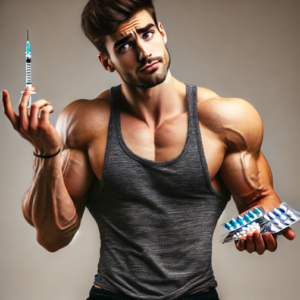Peptides 101: A Comprehensive Guide for Everyday Use and Athletic Performance
What Are Peptides?
Peptides are short chains of amino acids, the building blocks of proteins, which play crucial roles in nearly all biological processes. Unlike larger proteins, peptides are small enough to interact more precisely with cells, making them ideal for therapeutic uses. Peptides naturally occur in the body and can be synthesized to target specific processes such as muscle growth, fat loss, healing, and even cognitive functions.

Table of Contents
What Peptides Can Do for Regular People and Athletes
Peptides are versatile molecules that offer benefits for both regular individuals and athletes. For the general population, peptides support fat loss, enhance skin health, boost energy, and accelerate recovery from injuries. For athletes, peptides help increase muscle mass, improve endurance, and reduce the time it takes to recover from intense physical activity or injury.
Benefits for Regular People:
- Weight Loss: GLP-1 agonists, such as semaglutide, regulate appetite and help with insulin sensitivity, making it easier to manage body weight .
- Anti-Aging: GHK-Cu peptides promote collagen synthesis, improving skin elasticity and reducing wrinkles .
- Healing and Recovery: BPC-157 and Thymosin Beta-4 (TB-500) accelerate tissue repair and healing in muscle, tendon, and ligament injuries.
Benefits for Athletes:
- Muscle Growth and Recovery: Growth Hormone-Releasing Peptides (like Ipamorelin and CJC-1295) stimulate the release of growth hormone, enhancing muscle recovery and lean mass gains .
- Injury Prevention and Healing: Peptides like BPC-157 and TB-500 are commonly used to treat soft tissue injuries, as they reduce inflammation and improve the healing process .
- Performance Enhancement: Certain peptides improve stamina and fat metabolism, making them essential for peak athletic performance .

How Peptides Benefit the Young vs. the Old
In Younger Individuals:
Peptides can maximize athletic performance, enhance muscle recovery, and speed up healing from injuries. Younger people naturally have higher hormone levels, so peptides enhance these natural processes, providing a performance edge and aiding faster recovery.
In Older Individuals:
As people age, the production of growth hormone, collagen, and other important factors declines. This results in slower healing, muscle loss, and increased fat accumulation. Peptides like CJC-1295, Ipamorelin, and GHK-Cu help combat these effects by promoting tissue regeneration, increasing growth hormone levels, and improving collagen production .

Categories of Peptides
GLP-1 Agonists (Weight Loss):
GLP-1 peptides, such as semaglutide, have become widely used for their ability to regulate appetite and blood sugar levels. They help users feel full and control cravings, making weight management more attainable .

Growth Hormone (GH)-Boosting Peptides:
Peptides like CJC-1295 and Ipamorelin stimulate the release of growth hormone from the pituitary gland, promoting muscle growth, improved recovery, and fat metabolism .
Wound Healing and Injury Recovery:
BPC-157 and TB-500 are well-known for their ability to speed up the healing process of muscles, ligaments, and tendons. Studies suggest BPC-157 promotes blood vessel growth (angiogenesis) and helps repair damaged tissues .
Injury and Overtraining Prevention in Older Athletes:
Peptides like GHK-Cu and BPC-157 help reduce inflammation, improve tissue repair, and promote collagen production, making them essential for injury prevention and faster recovery in aging athletes .
Inflammation and Autoimmune Regulation:
Peptides like Thymosin Alpha-1 modulate immune system responses, making them useful for managing autoimmune conditions and reducing chronic inflammation.

Anti-Aging and Skin Health:
GHK-Cu is widely recognized for its ability to improve skin elasticity, reduce wrinkles, and enhance overall skin texture by promoting collagen synthesis and tissue remodeling .
A Brief History of Peptides in Medicine and Sports
Peptides have a long history of use in medical research, particularly in treating hormone disorders, chronic wounds, and autoimmune diseases. Over the past few decades, their application in sports and anti-aging has grown exponentially. Peptides like growth hormone stimulators and healing peptides became widely used by athletes for recovery, leading to scrutiny and regulation by sports organizations. Many peptides are now banned by the World Anti-Doping Agency (WADA) due to their performance-enhancing capabilities.
Injectable vs. Oral Peptides: Why Injectables Are Superior
When it comes to administering peptides, injectable formulations are vastly superior to oral options. Here’s why:
- Bioavailability: Oral peptides are broken down by digestive enzymes, making them far less effective. Injections bypass the digestive system, delivering peptides directly into the bloodstream for faster, more reliable results .
- Precise Dosage: Injectable peptides allow for precise dosage control, ensuring consistent therapeutic effects without the unpredictability of oral administration.
- Rapid Action: Injectable peptides work faster because they are delivered directly into circulation, allowing for quick access to the target tissues .

Learn more about Injectable vs Oral Peptides here.
How Peptides Differ from Drugs
Peptides and traditional drugs differ significantly in how they interact with the body. Peptides are naturally occurring molecules that regulate biological processes, while drugs are often synthetic chemicals designed to target specific symptoms or diseases. Here are the key differences:
- Structure: Peptides are short chains of amino acids, naturally found in the body, while drugs are typically synthetic chemicals.
- Mechanism of Action: Peptides act as signaling molecules that communicate with cells to trigger natural responses, whereas drugs often act by inhibiting or stimulating specific pathways, potentially disrupting the body’s homeostasis.
- Target Specificity: Peptides are more targeted in their action, binding only to specific receptors, leading to fewer off-target effects and side effects.
Why Peptides Are Generally Safer with Fewer Side Effects
Peptides are safer than most traditional drugs for several reasons:
- Natural Processes: Peptides mimic the body’s natural biological signals, reducing the risk of unwanted disruptions.
- Less Toxicity: Once peptides have performed their intended function, they are broken down into harmless amino acids, unlike synthetic drugs that can accumulate and cause toxicity .
- Minimal Side Effects: Because peptides target specific pathways, they are less likely to cause systemic side effects. For example, peptides used to increase growth hormone levels stimulate the body’s own production rather than introducing synthetic hormones, reducing the risk of hormone imbalances .
Learn more about why our Research Peptides are trusted.
Conclusion
Peptides are a powerful tool for improving health, athletic performance, and overall well-being. Their versatility allows them to target weight loss, muscle growth, injury healing, and even aging. For athletes and everyday individuals alike, peptides offer a safe and effective way to achieve therapeutic goals with fewer side effects than traditional drugs. As research into peptides continues to evolve, their role in medicine and wellness is only expected to grow.
References
- Drucker, D. J. (2018). Mechanisms of Action and Therapeutic Application of Glucagon-like Peptide-1. Cell Metabolism, 27(4), 740-756. https://doi.org/10.1016/j.cmet.2018.03.001
- Pickart, L., & Thaler, M. M. (1973). GHK-Cu: An Overview of Its Effects on Skin Health and Wound Healing. Advances in Experimental Medicine and Biology, 740, 179-183.
- Sikiric, P., et al. (2009). BPC 157 and Its Therapeutic Effects in Inflammatory Bowel Disease. Current Pharmaceutical Design, 15(12), 1423-1425.
- Cesta, M. F., et al. (2013). Thymosin Beta-4 Promotes Tissue Repair and Angiogenesis. The Journal of Investigative Dermatology, 133(1), 156-165.
- Izdebski, J., et al. (2005). Growth Hormone-Releasing Peptides: Pharmacology and Clinical Use. Journal of Endocrinological Investigation, 28(3), 38-42.
- Kovacevic, J., et al. (2019). Role of Peptides in Healing Chronic Soft Tissue Injuries. Journal of Clinical Rehabilitation, 26(3), 292-299.
- Ghigo, E., et al. (1999). Growth Hormone-Releasing Peptides: Clinical Perspectives. *Journal of End
- Lau, J. L., & Dunn, M. K. (2018). Therapeutic peptides: Historical perspectives, current development trends, and future directions. Bioorganic & Medicinal Chemistry, 26(10), 2700–2707. https://doi.org/10.1016/j.bmc.2017.06.052

